Priority Branches for Ship Detection in Optical Remote Sensing Images
Abstract
1. Introduction
- Side-by-side ships. In previous works, bounding boxes are produced to cover the area of ships. To avoid repeated bounding boxes on the same ship, researchers apply a non-maximum suppression (NMS) or soft-NMS strategy [22] that prevents bounding boxes from having a large overlap with the most likely box. However, the drawback to this strategy is that if ships are close together, boxes belonging to different ships will be eliminated until down to only one. Therefore, some side-by-side ships will be missed.
- Ship-like objects. Some ship-like objects will be mistaken for ships. This can be attributed to algorithms’ insufficient ability to perform feature extraction, and a lack of negative samples.
- Multi-scale ships. If ships of different sizes gather, the smaller ships are often missed by detectors. Multi-scale outputs are designed to predict ships with different sizes in different modules. This method decreases the number of missed multi-scale ships but does not completely eliminate the possibility of missing them.
- A state-of-the-art performance detector is proposed in this paper. Priority branches for CNN ship detectors are specially designed, and PBS is used to filter potential outputs from branches.
- To obtain more samples, we add 360 ORS ship images collected from Google Earth to the HRSC2016 dataset [24]. In our dataset, ships include warcrafts, aircraft carriers, and cargo and passenger ships. We re-annotate the dataset with consistent standards. If a ship is completely displayed in an image, we distinguish whether it is a large ship or a small ship based on whether its bounding box area is larger than 96 × 96 pixels. For those displayed incompletely, we labeled them as incomplete ships. Detecting results of large ships, small ships and incomplete ships are involved in our stricter evaluation metrics.
2. Methodology
2.1. Feature Fusion Backbone
2.1.1. Deep Layer Aggregation
2.1.2. Deformable Convolution
2.2. Priority Branches
2.2.1. Recall-Priority Branch
2.2.2. Precision-Priority Branch
2.3. Priority-Based Selection
- If has a high overlap with , we reserve .
- If a box has low or no overlap with all boxes from the other branch, and its confidence is higher than the threshold (the threshold is less strict for precision-priority branch), we reserve it.
3. Experiments and Results
3.1. Dataset
3.2. Evaluation Metrics
3.3. Compared Methods
3.4. Implementation Details
3.5. Results
4. Conclusions
Author Contributions
Funding
Acknowledgments
Conflicts of Interest
References
- Li, Y.; Martinis, S.; Wieland, M. Urban flood mapping with an active self-learning convolutional neural network based on TerraSAR-X intensity and interferometric coherence. ISPRS J. Photogramm. Remote Sens. 2019, 152, 178–191. [Google Scholar] [CrossRef]
- Sun, S.; Li, C.; Chee, P.W.; Paterson, A.H.; Jiang, Y.; Xu, R.; Shehzad, T. Three-dimensional photogrammetric mapping of cotton bolls in situ based on point cloud segmentation and clustering. ISPRS J. Photogramm. Remote Sens. 2020, 160, 195–207. [Google Scholar] [CrossRef]
- Dong, C.; Liu, J.; Xu, F. Ship detection in optical remote sensing images based on saliency and a rotation-invariant descriptor. Remote Sens. 2018, 10, 400. [Google Scholar] [CrossRef]
- Barnum, J. Ship detection with high-resolution HF skywave radar. IEEE J. Ocean. Eng. 1986, 11, 196–209. [Google Scholar] [CrossRef]
- Tian, Y.; Wang, C.; Zhang, H. Spaceborne SAR Ship Detection and its Application on Marine fisheries monitoring. Remote Technol. Appl. 2007, 22, 503–512. [Google Scholar]
- Novak, L.M.; Halversen, S.D.; Owirka, G.; Hiett, M. Effects of polarization and resolution on SAR ATR. IEEE Trans. Aerosp. Electron. Syst. 1997, 33, 102–116. [Google Scholar] [CrossRef]
- Vachon, P.W.; Adlakha, P.; Edel, H.; Henschel, M.; Ramsay, B.; Flett, D.; Thomas, S. Canadian progress toward marine and coastal applications of synthetic aperture radar. Johns Hopkins APL Tech. Digest. 2000, 21, 33–40. [Google Scholar]
- Kaplan, L.M. Improved SAR target detection via extended fractal features. IEEE Trans. Aerosp. Electron. Syst. 2001, 37, 436–451. [Google Scholar] [CrossRef]
- Copeland, A.C.; Ravichandran, G.; Trivedi, M.M. Localized Radon transform-based detection of ship wakes in SAR images. IEEE Trans. Geosci. Remote Sens. 1995, 33, 35–45. [Google Scholar] [CrossRef]
- Proia, N.; Pagé, V. Characterization of a Bayesian ship detection method in optical satellite images. IEEE Geosci. Remote Sens. Lett. 2009, 7, 226–230. [Google Scholar] [CrossRef]
- Shu, C.; Ding, X.; Fang, C. Histogram of the oriented gradient for face recognition. Tsinghua Sci. Technol. 2011, 16, 216–224. [Google Scholar] [CrossRef]
- Liu, G.; Zhang, Y.; Zheng, X.; Sun, X.; Fu, K.; Wang, H. A new method on inshore ship detection in high-resolution satellite images using shape and context information. IEEE Geosci. Remote. Sens. Lett. 2013, 11, 617–621. [Google Scholar] [CrossRef]
- Yu, Y.; Guan, H.; Li, D.; Gu, T.; Tang, E.; Li, A. Orientation guided anchoring for geospatial object detection from remote sensing imagery. ISPRS J. Photogramm. Remote. Sens. 2020, 160, 67–82. [Google Scholar] [CrossRef]
- Lin, H.; Shi, Z.; Zou, Z. Fully convolutional network with task partitioning for inshore ship detection in optical remote sensing images. IEEE Geosci. Remote. Sens. Lett. 2017, 14, 1665–1669. [Google Scholar] [CrossRef]
- Xie, X.; Li, B.; Wei, X. Ship Detection in Multispectral Satellite Images Under Complex Environment. Remote Sens. 2020, 12, 792. [Google Scholar] [CrossRef]
- Chen, Y.; Li, Y.; Wang, J.; Chen, W.; Zhang, X. Remote Sensing Image Ship Detection under Complex Sea Conditions Based on Deep Semantic Segmentation. Remote Sens. 2020, 12, 625. [Google Scholar] [CrossRef]
- Dechesne, C.; Lefèvre, S.; Vadaine, R.; Hajduch, G.; Fablet, R. Ship Identification and Characterization in Sentinel-1 SAR Images with Multi-Task Deep Learning. Remote Sens. 2019, 11, 2997. [Google Scholar] [CrossRef]
- Rostami, M.; Kolouri, S.; Eaton, E.; Kim, K. Deep Transfer Learning for Few-Shot SAR Image Classification. Remote Sens. 2019, 11, 1374. [Google Scholar] [CrossRef]
- Ren, S.; He, K.; Girshick, R.; Sun, J. Faster r-cnn: Towards real-time object detection with region proposal networks. IEEE Trans. Pattern Anal. Mach. Intell. 2017, 39, 1137–1149. [Google Scholar] [CrossRef]
- Zhang, S.; Wu, R.; Xu, K.; Wang, J.; Sun, W. R-CNN-based ship detection from high resolution remote sensing imagery. Remote Sens. 2019, 11, 631. [Google Scholar] [CrossRef]
- Zhang, Z.; Guo, W.; Zhu, S.; Yu, W. Toward arbitrary-oriented ship detection with rotated region proposal and discrimination networks. IEEE Geosci. Remote Sens. Lett. 2018, 15, 1745–1749. [Google Scholar] [CrossRef]
- Bodla, N.; Singh, B.; Chellappa, R.; Davis, L.S. Soft-NMS--improving object detection with one line of code. In Proceedings of the 2017 IEEE International Conference on Computer Vision, Venice, Italy, 22–29 October 2017; pp. 5561–5569. [Google Scholar]
- Yu, F.; Wang, D.; Shelhamer, E.; Darrell, T. Deep layer aggregation. In Proceedings of the 2018 IEEE Conference on Computer Vision and Pattern Recognition, Salt Lake City, UT, USA, 18–23 June 2018; pp. 2403–2412. [Google Scholar]
- LB, W. A high resolution optical satellite image dataset for ship recognition and some new baselines. In Proceedings of the 6th International Conference on Pattern Recognition Applications and Methods, Porto, Portugal, 24–26 February 2017. [Google Scholar]
- Zhou, X.; Wang, D.; Krähenbühl, P. Objects as Points. arXiv 2019, arXiv:1904.07850. [Google Scholar]
- Zhu, X.; Hu, H.; Lin, S.; Dai, J. Deformable convnets v2: More deformable, better results. In Proceedings of the 2019 IEEE Conference on Computer Vision and Pattern Recognition, Long Beach, CA, USA, 15–20 June 2019; pp. 9308–9316. [Google Scholar]
- Dai, J.; Qi, H.; Xiong, Y.; Li, Y.; Zhang, G.; Hu, H.; Wei, Y. Deformable convolutional networks. In Proceedings of the 2017 IEEE International Conference on Computer Vision, Venice, Italy, 22–29 October 2017; pp. 764–773. [Google Scholar]
- Cao, Z.; Simon, T.; Wei, S.E.; Sheikh, Y. Realtime multi-person 2d pose estimation using part affinity fields. In Proceedings of the 2017 IEEE Conference on Computer Vision and Pattern Recognition, Honolulu, HI, USA, 21–26 July 2017; pp. 7291–7299. [Google Scholar]
- Newell, A.; Yang, K.; Deng, J. Stacked hourglass networks for human pose estimation. In Proceedings of the 2016 European Conference on Computer Vision, Amsterdam, The Netherlands, 8–16 October 2016; pp. 483–499. [Google Scholar]
- Law, H.; Deng, J. Cornernet: Detecting objects as paired keypoints. In Proceedings of the 2018 European Conference on Computer Vision, Munich, Germany, 8–14 September 2018; pp. 734–750. [Google Scholar]
- Lin, T.Y.; Goyal, P.; Girshick, R.; He, K.; Dollár, P. Focal loss for dense object detection. In Proceedings of the 2017 IEEE International Conference on Computer Vision, Venice, Italy, 22–29 October 2017; pp. 2980–2988. [Google Scholar]
- Redmon, J.; Farhadi, A. Yolov3: An Incremental Improvement. arXiv 2018, arXiv:1804.02767. [Google Scholar]
- Lin, T.Y.; Dollár, P.; Girshick, R.; He, K.; Hariharan, B.; Belongie, S. Feature pyramid networks for object detection. In Proceedings of the 2017 IEEE Conference on Computer Vision and Pattern Recognition, Honolulu, HI, USA, 21–26 July 2017; pp. 2117–2125. [Google Scholar]
- Tan, M.; Pang, R.; Le, Q.V. Efficientdet: Scalable and Efficient Object Detection. arXiv 2019, arXiv:1911.09070. [Google Scholar]
- Zhuang, S.; Wang, P.; Jiang, B.; Wang, G.; Wang, C. A Single Shot Framework with Multi-Scale Feature Fusion for Geospatial Object Detection. Remote Sens. 2019, 11, 594. [Google Scholar] [CrossRef]
- Liu, S.; Qi, L.; Qin, H.; Shi, J.; Jia, J. Path aggregation network for instance segmentation. In Proceedings of the 2018 IEEE Conference on Computer Vision and Pattern Recognition, Salt Lake City, UT, USA, 18–23 June 2018; pp. 8759–8768. [Google Scholar]
- Lin, T.Y.; Maire, M.; Belongie, S.; Hays, J.; Perona, P.; Ramanan, D.; Zitnick, C.L. Microsoft coco: Common objects in context. In Proceedings of the 2014 European Conference on Computer Vision, Zurich, Switzerland, 6–12 September 2014; pp. 740–755. [Google Scholar]
- Zhu, C.; He, Y.; Savvides, M. Feature selective anchor-free module for single-shot object detection. In Proceedings of the 2019 IEEE Conference on Computer Vision and Pattern Recognition, Long Beach, CA, USA, 15–20 June 2019; pp. 840–849. [Google Scholar]
- Kingma, D.P.; Ba, J. Adam: A Method for Stochastic Optimization. arXiv 2014, arXiv:1412.6980. [Google Scholar]
- Deng, J.; Dong, W.; Socher, R.; Li, L.J.; Li, K.; Fei-Fei, L. Imagenet: A large-scale hierarchical image database. In Proceedings of the 2009 IEEE Conference on Computer Vision and Pattern Recognition, Miami Beach, FL, USA, 20–25 June 2009; pp. 248–255. [Google Scholar]


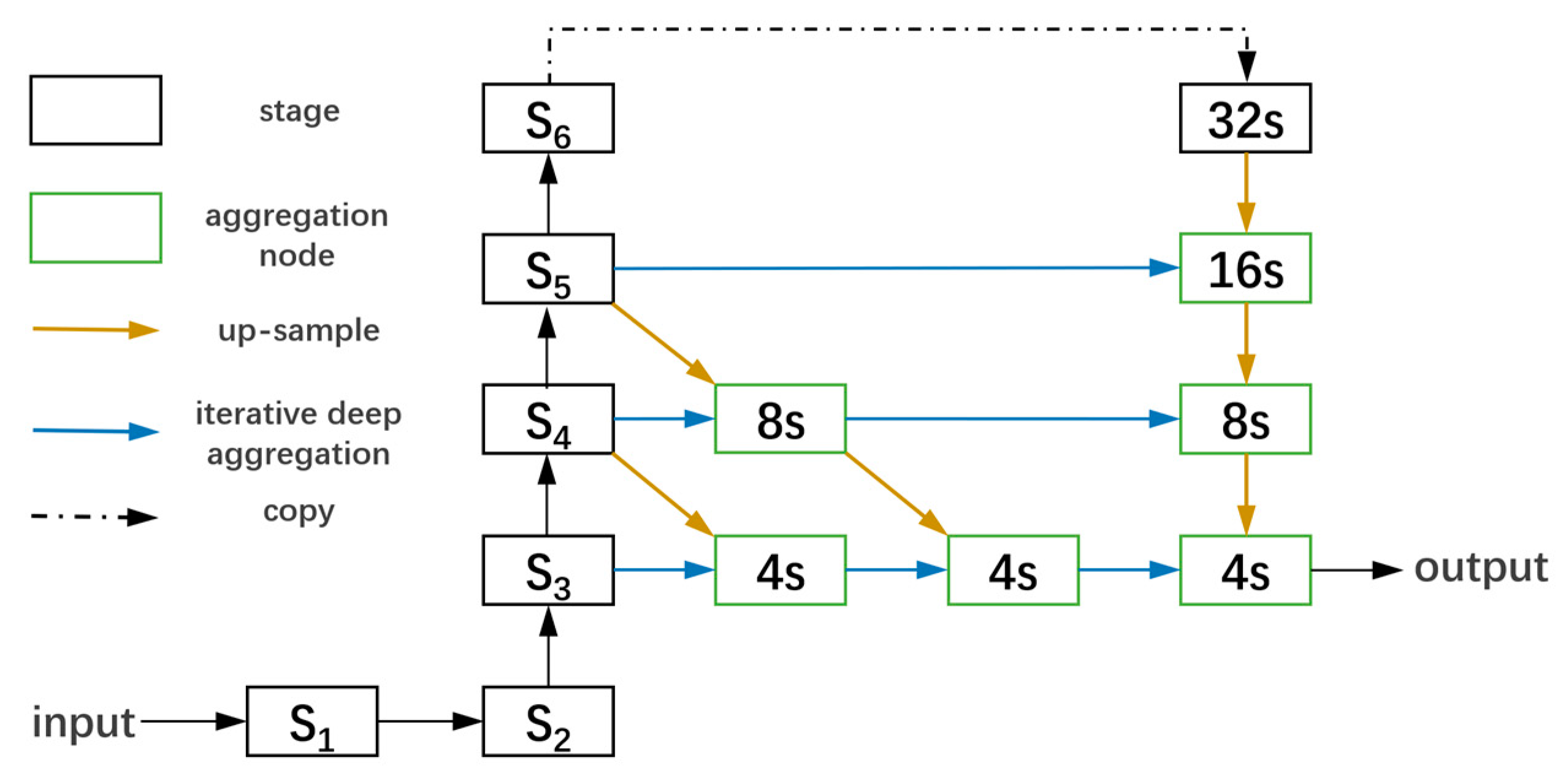

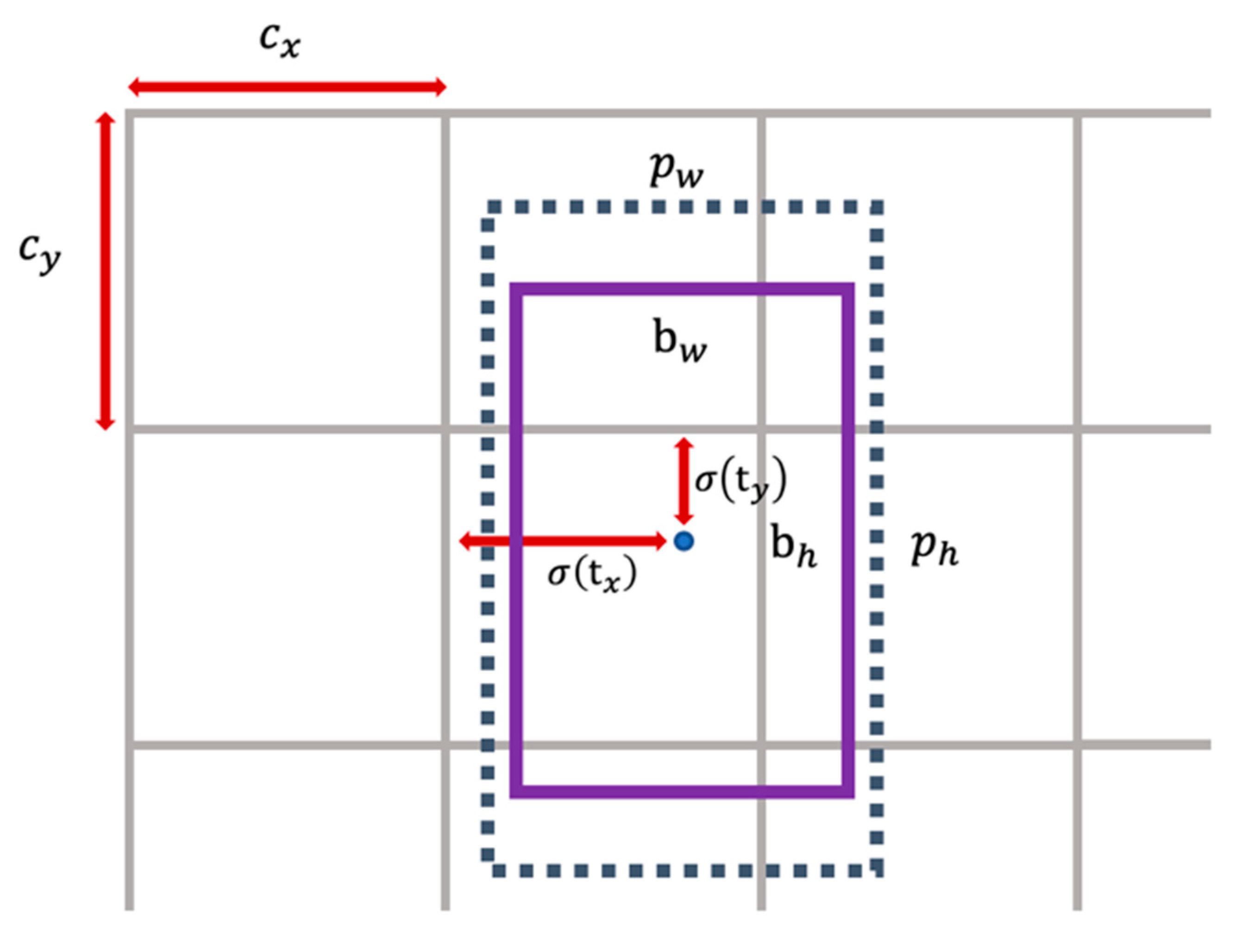
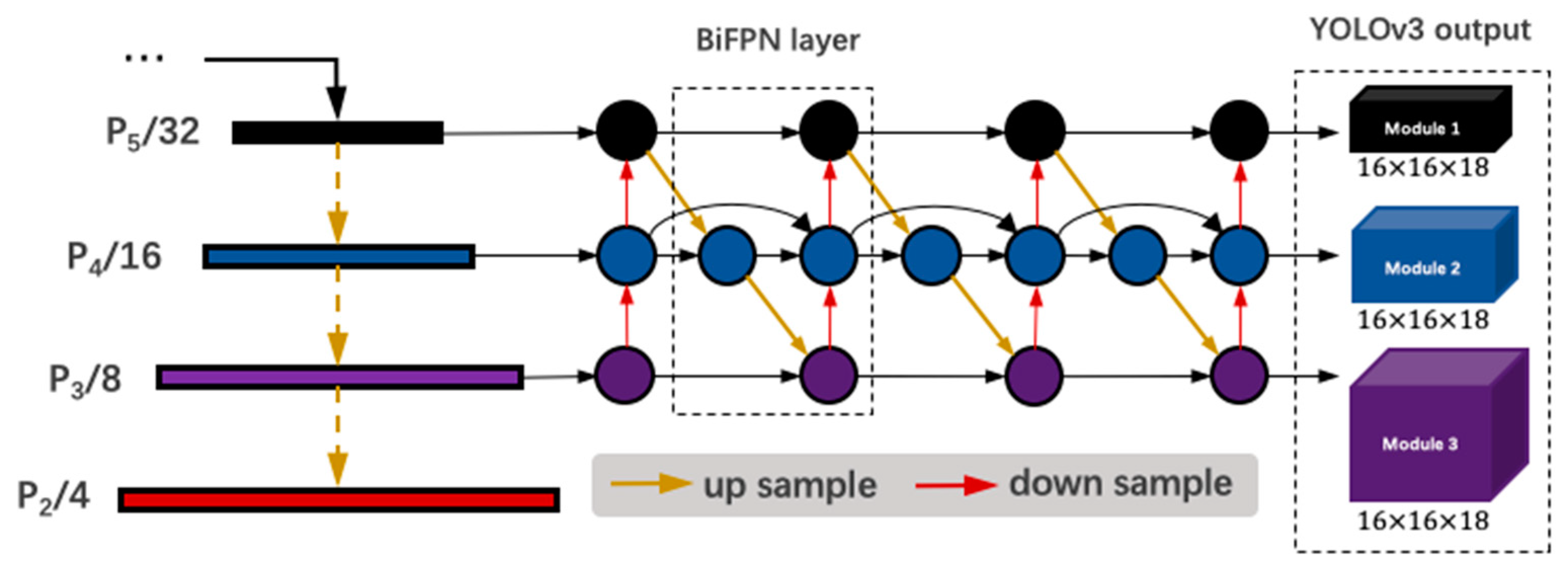
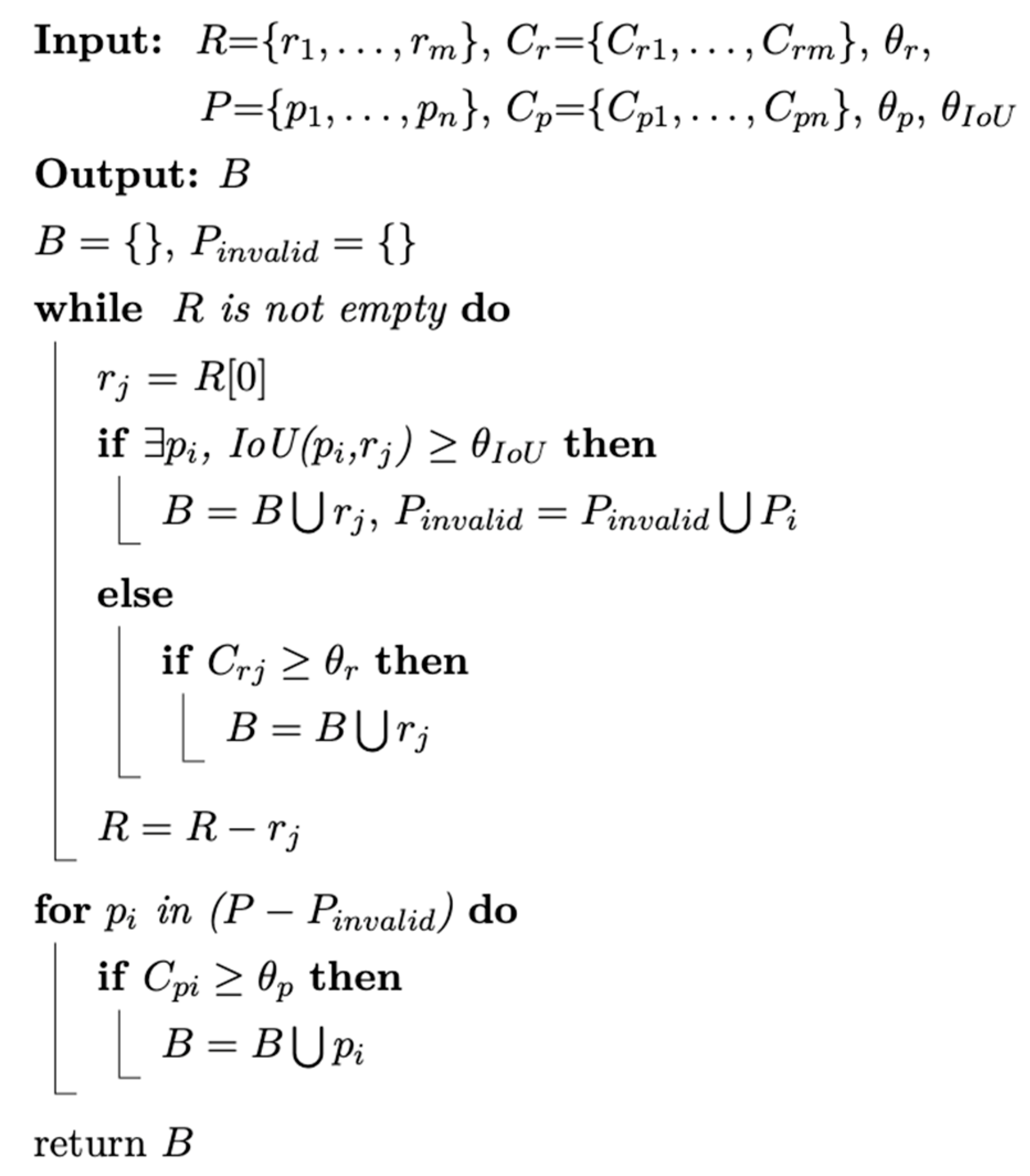
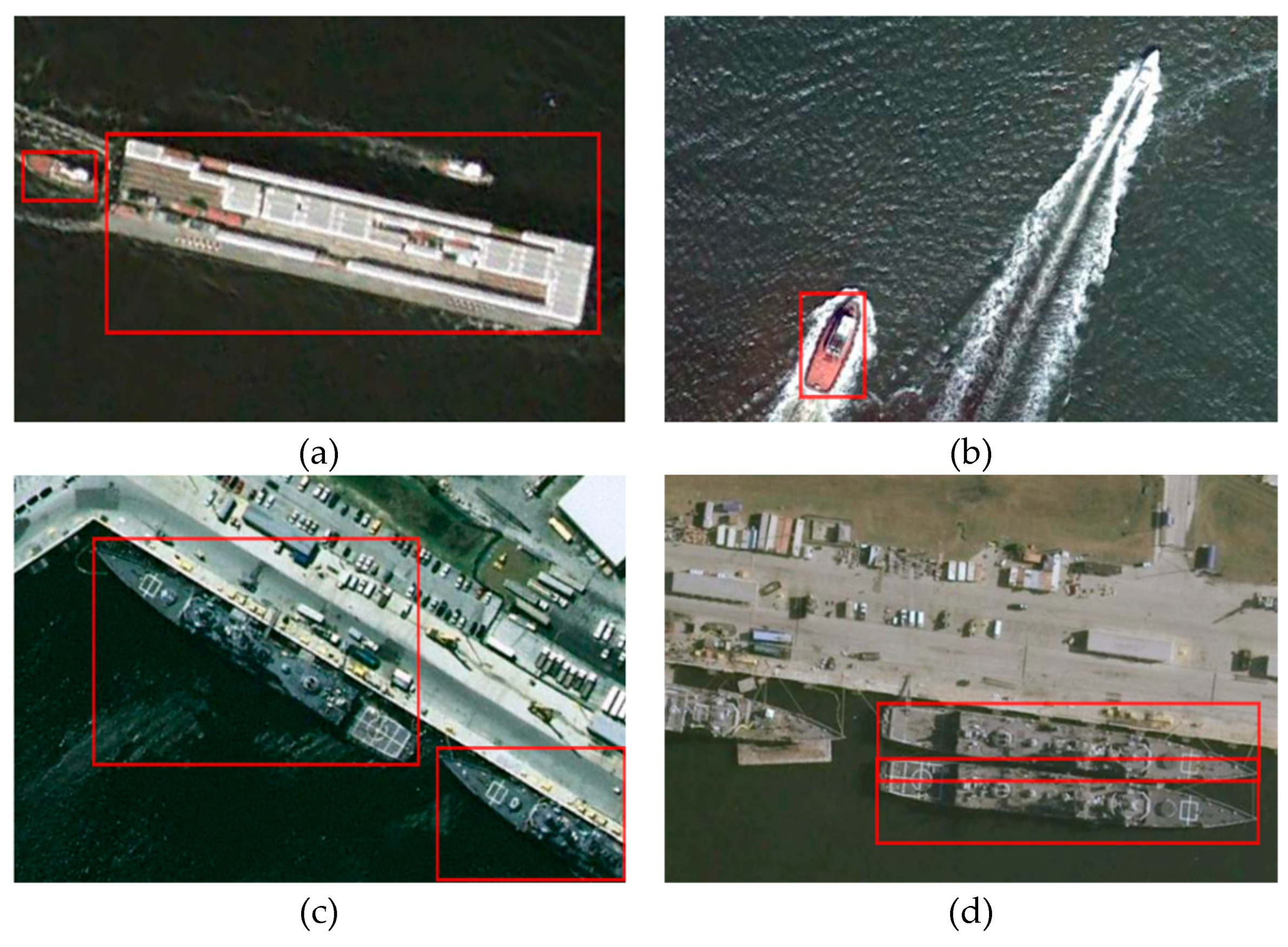
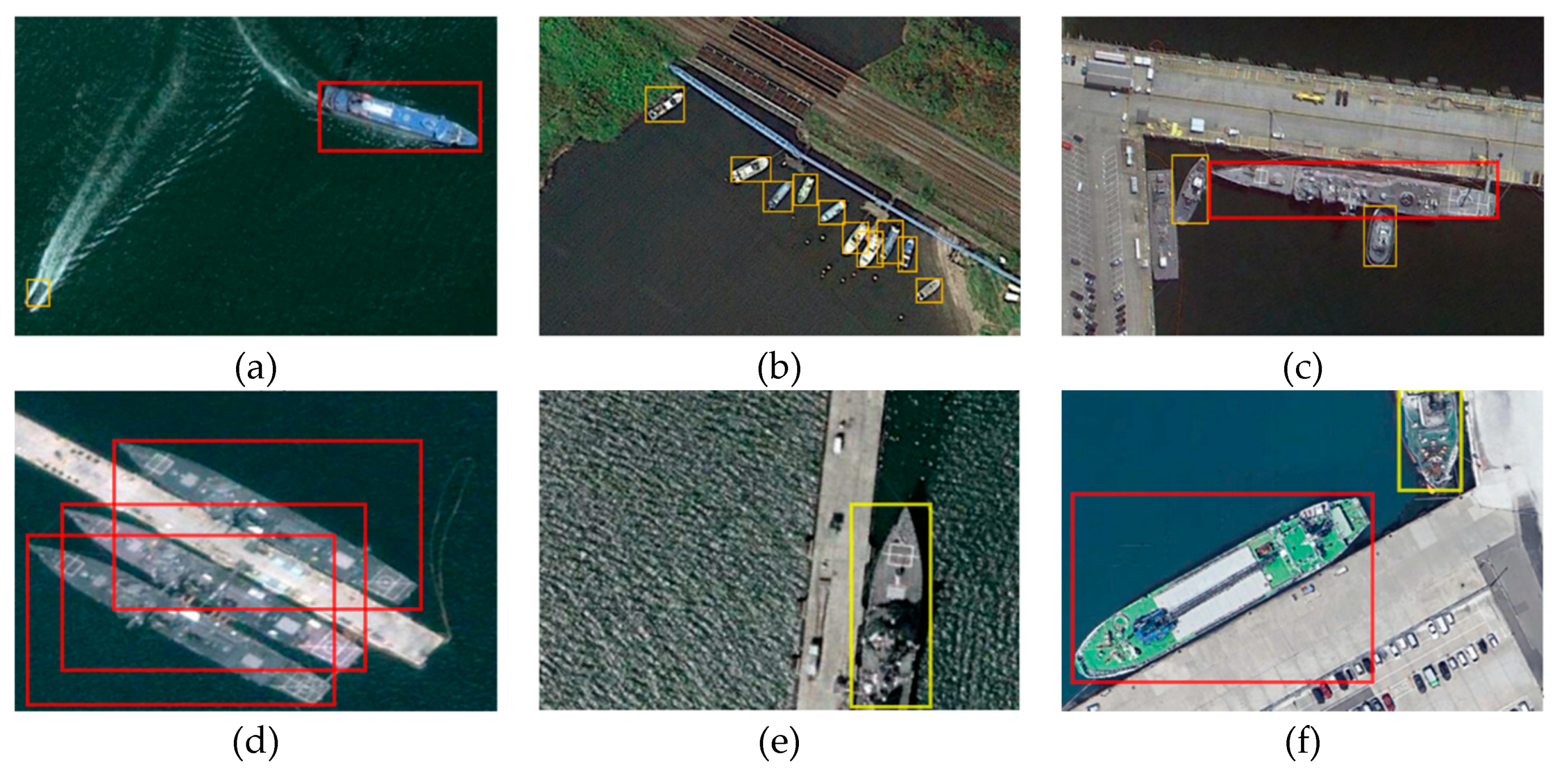
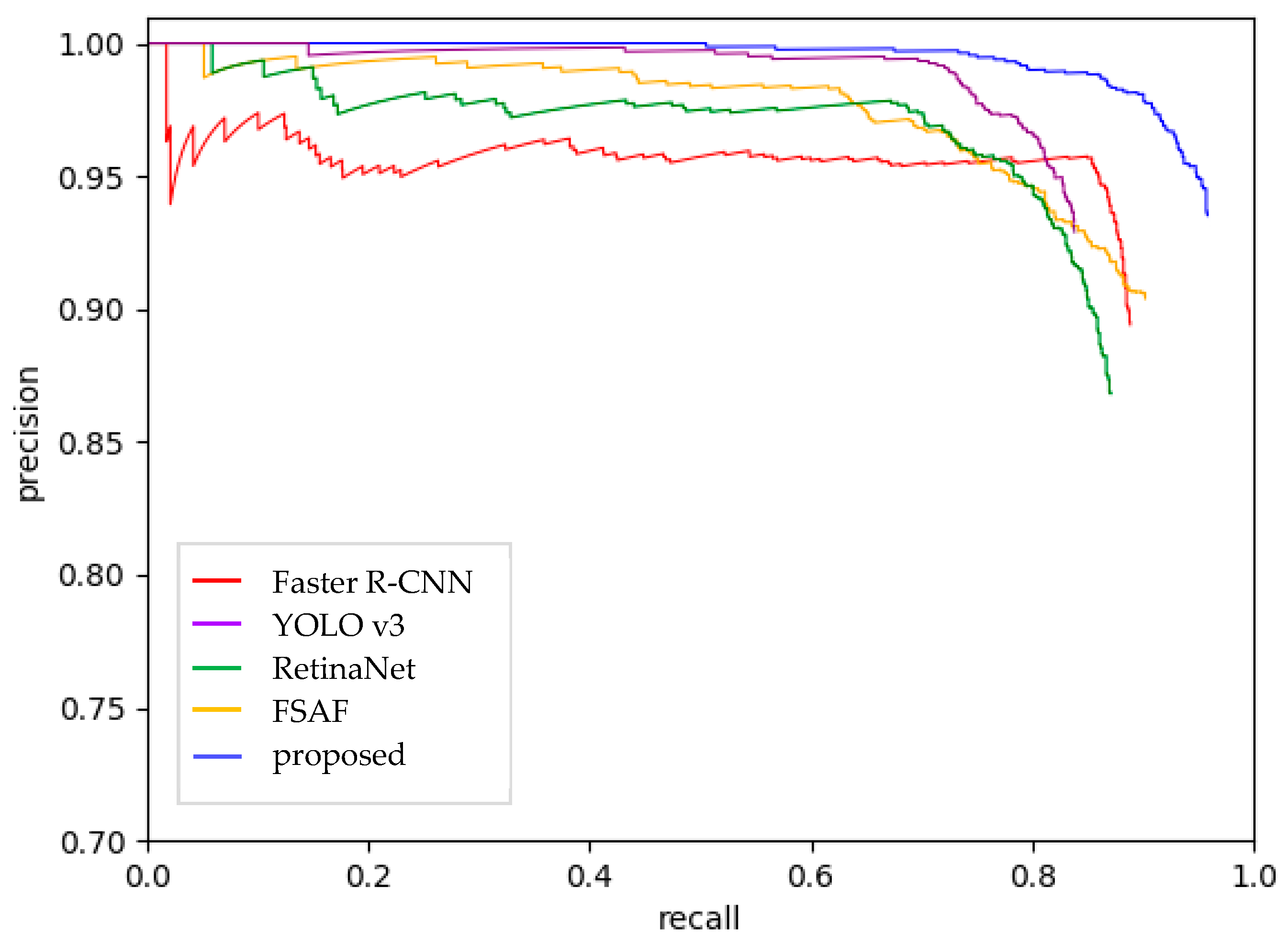
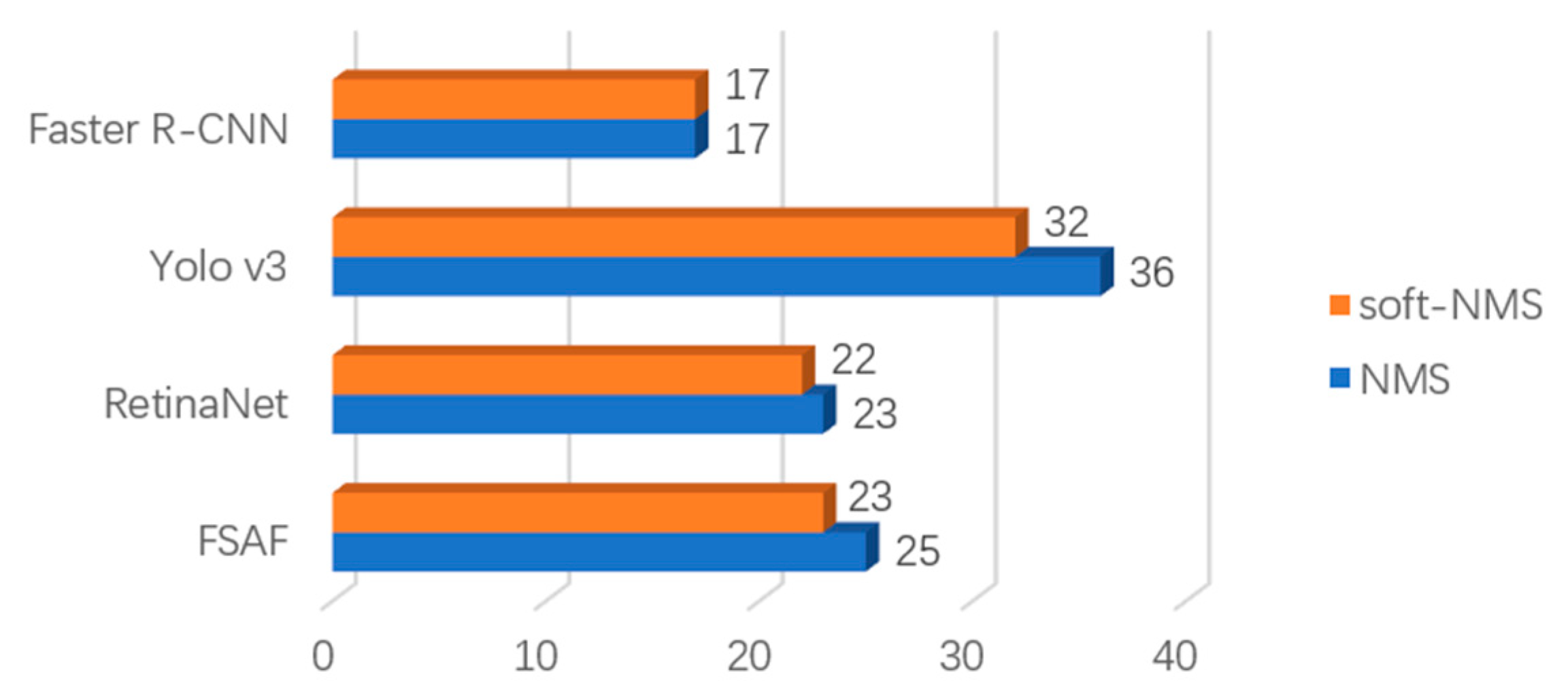

| Levels | Number of Samples | ||
|---|---|---|---|
| Training Set | Validation Set | Testing Set | |
| Large | 2204 | 285 | 1059 |
| Small | 825 | 70 | 333 |
| Incomplete | 181 | 11 | 90 |
| Total | 3210 | 366 | 1482 |
| Methods | P & R (%) | AP Values (%) | ||||
|---|---|---|---|---|---|---|
| P | R | |||||
| Faster R-CNN | 90.50 | 89.95 | 86.95 | 94.14 | 69.94 | 59.46 |
| YOLOv3 | 93.24 | 83.81 | 83.27 | 92.73 | 58.47 | 52.45 |
| RetinaNet | 87.90 | 88.19 | 86.28 | 94.55 | 66.43 | 56.06 |
| FSAF | 91.55 | 91.36 | 89.71 | 96.12 | 76.23 | 53.32 |
| Proposed | 94.02 | 96.02 | 95.57 | 99.42 | 83.14 | 78.51 |
| Methods | False Alarms | Missed Ships | ||
|---|---|---|---|---|
| Side-by-Side Ships | Incomplete Ships | Multi-Scale Ships | ||
| Faster R-CNN | 140 | 17 | 34 | 98 |
| YOLOv3 | 90 | 36 | 41 | 177 |
| RetinaNet | 180 | 23 | 36 | 116 |
| FSAF | 125 | 25 | 38 | 65 |
| Proposed | 90 | 0 | 15 | 44 |
| Modules | Precision (%) | Recall (%) |
|---|---|---|
| Precision-Priority Branch | 94.68 | 86.17 |
| Recall-Priority Branch | 90.11 | 95.48 |
| PBS | 94.02 | 96.02 |
| Methods | Pretrained Backbone | Frames per Second |
|---|---|---|
| Faster R-CNN | ResNet-50 | 20.2 |
| YOLOv3 | Darknet-53 | 75.1 |
| RetinaNet | ResNet-50 | 33.5 |
| FSAF | ResNet-50 | 43.0 |
| Proposed | DLA-34 | 55.8 |
© 2020 by the authors. Licensee MDPI, Basel, Switzerland. This article is an open access article distributed under the terms and conditions of the Creative Commons Attribution (CC BY) license (http://creativecommons.org/licenses/by/4.0/).
Share and Cite
Zhang, Y.; Sheng, W.; Jiang, J.; Jing, N.; Wang, Q.; Mao, Z. Priority Branches for Ship Detection in Optical Remote Sensing Images. Remote Sens. 2020, 12, 1196. https://doi.org/10.3390/rs12071196
Zhang Y, Sheng W, Jiang J, Jing N, Wang Q, Mao Z. Priority Branches for Ship Detection in Optical Remote Sensing Images. Remote Sensing. 2020; 12(7):1196. https://doi.org/10.3390/rs12071196
Chicago/Turabian StyleZhang, Yijia, Weiguang Sheng, Jianfei Jiang, Naifeng Jing, Qin Wang, and Zhigang Mao. 2020. "Priority Branches for Ship Detection in Optical Remote Sensing Images" Remote Sensing 12, no. 7: 1196. https://doi.org/10.3390/rs12071196
APA StyleZhang, Y., Sheng, W., Jiang, J., Jing, N., Wang, Q., & Mao, Z. (2020). Priority Branches for Ship Detection in Optical Remote Sensing Images. Remote Sensing, 12(7), 1196. https://doi.org/10.3390/rs12071196





